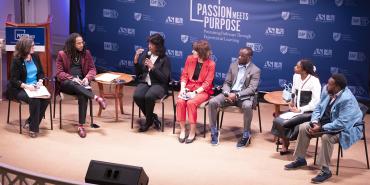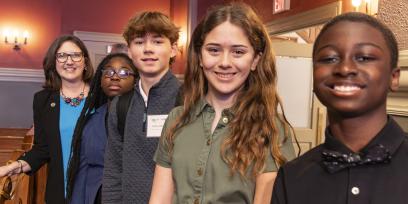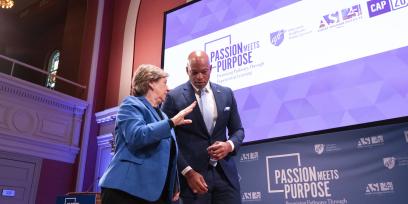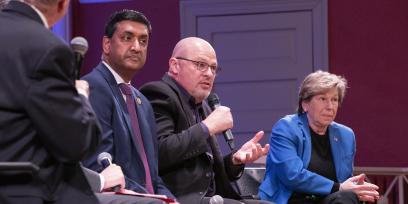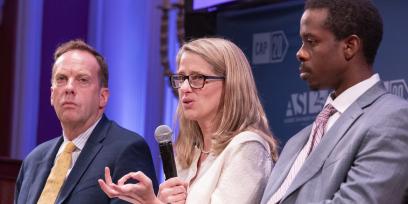A constellation of experiential learning proponents, from the governor of Maryland to the president of the AFL-CIO as well as AFT President Randi Weingarten and the AFT teachers most immersed in this work gathered at a conference March 21 to showcase the power of hands-on learning and strategize on how to expand its reach. Co-sponsored by the AFT, the Albert Shanker Institute and the Center for American Progress, the convening underscored the potential for engaging students and creating multiple pathways to fulfilling work lives through career and technical education.
Participants agreed that showing the promise of CTE as separate from purely academic learning is crucial. “These are noble, fantastic jobs and careers,” said Weingarten, describing the thriving CTE programs she has visited across the country. “Let’s not always say ‘college, college, college.’ As educators, our jobs are to prepare our kids for life, for career, for college, for civic opportunities and engagement.”
AFL-CIO President Liz Shuler described her own family’s trajectory: When her father returned from Vietnam, he tried college on the GI Bill but “it wasn’t for him,” so he went through an electrical apprenticeship program and started a career that allowed the family to have a middle-class life—in large part thanks to the International Brotherhood of Electrical Workers. “We in labor have been the center of gravity for workers who are looking for that next opportunity,” she said. “We have to have multiple pathways to good careers.”
Success stories
Experiential learning goes a long way in engaging students; and examples of its success abound. At the event, journalism students from D.C. Public Schools were learning their trade, recording the discussions, attending a press event, and taping an interview with Maryland Gov. Wes Moore.
Elsewhere in Washington, D.C., teacher Raphael Bonhomme has engaged his third-graders by asking them what they’d like to change about their community, then helping them reach out to elected officials with their ideas. This civic engagement made the children feel like “they could actually make a change and a difference,” said Bonhomme; one child, who suggested a community garden for the neighborhood, got an email reply from the city’s Advisory Neighborhood Commission representative to say that a garden was now in the works.
In the Anoka-Hennepin school district in Minnesota, educators transformed a shopping mall into work stations for students who run “shops” preparing and selling donated clothing, maintaining a food pantry and running a laundry for school team uniforms. That experience helps them secure jobs at local businesses later on, said Valerie Holthus, president of Anoka-Hennepin Education Minnesota, and helps them focus on their studies. “My students are best when they’re doing hands-on activities,” she said. “In these programs, our behavior referrals are zero.”
S. Kwesi Rollins, vice president for leadership and engagement at the Institute for Educational Leadership, described an Alabama community school’s partnership with an organic farm and restaurant: Kids learn about farming, farm-to-table restaurants and food preparation; and their families get to eat at a great restaurant. “Not only is this about learning,” he said, “but it’s also about connection and it’s about community.”
These sorts of programs encourage students to stay in school as well. In fact, experiential learning programs stemmed from a desire to keep kids in school, said Michael Mulgrew, president of the United Federation of Teachers in New York City, where 130,000 students are enrolled in CTE classes. Teachers thought, “This style of learning will allow us to get more children to graduate on time,” he said, and statistics show it works: Graduation rates are about 93 percent for students who take at least two classes in high-quality CTE programs.
Value added
Along the way, students are developing essential skills like critical thinking, problem-solving, communication and collaboration. Azariah McLymore, a graduate of the Newburgh P-TECH Program in New York, studied cybersecurity but uses the teamwork and networking she learned there in a completely different job, as a lawyer and community advocate. U.S. Secretary of Education Miguel Cardona went to auto mechanics classes, and although he didn’t become a mechanic, the program “showed me I had the potential to solve problems,” he said. “I used my skills as a springboard for my passion.”
Employers say, “We hire for hard skills, we fire for soft skills,” said Manny Lamarre, deputy assistant secretary in the U.S. Department of Labor Employment and Training Administration.
In addition to helping students and boosting the economy by filling essential jobs, experiential learning can be a powerful community-building tool, said Gov. Moore, who launched a service year option in Maryland last year. Similar to internships and apprenticeships, the program places high school graduates in a variety of paid jobs, from home weatherization to tutoring, where they can find their passion and where they must work with others, in service. “In this time of political divisiveness, … I’m just a big believer that service will save us,” said Moore.
Challenges
Getting the resources needed to build such successful programs is not easy work. Rep. Ro Khanna (D-Calif.) said the gap between spending for academic programs and for CTE is deep. The CHIPS and Science Act and the Infrastructure Investment and Jobs Act championed by the Biden-Harris administration have provided much-needed funding to address this disparity—along with federal appropriations specifically for CTE, coming in at $1.4 billion.
But barriers remain. Chief among them are assessments still tied to standardized academic tests.
“You have to change the accountability system,” said Weingarten.
Mulgrew agreed, describing a system that prevents teachers from utilizing experiential learning because they are told that test scores are more important.
Other issues include CTE teachers’ salaries: Some CTE teachers can make much more money in the field, said Peggy Brookins, president and CEO of the National Board for Professional Teaching Standards, so it can be hard to retain them. Many need more professional development. Students are still plagued by low expectations and stigma, being labeled as “less than” when they choose a career pathway that is not purely academic. As Gov. Moore put it, paraphrasing Albert Einstein, “If you tell a fish that the definition of ‘genius’ is to climb a tree, then the fish will always feel insufficient.”
Solutions
Partnerships, participants agreed, are a big part of the answer, not just with government, labor and education but with industry. One of CTE’s critical components is the reciprocal benefit it offers both to students (who get stable, well-paid jobs) and to industry (which gets a reliable, well-educated and well-prepared workforce).
For example, Microsoft needs computer-literate workers, but Allyson Knox, director of education policy and programs there, says only 57 percent of high schools offer computer science. So Microsoft has paired industry professionals with teachers to co-teach computer science, and used its “political currency” to help qualify computer science classes as one of the math or science credits required for high school graduation.
In central New York, Micron has committed to partner with the AFT, UFT, New York State United Teachers and Gov. Kathy Hochul to build the New York Advanced Technology Framework, a plan that will train middle school and high school students for high-tech jobs and careers. The company will also contribute to a new science, technology, arts and science high school going up in Syracuse, where students may eventually be part of the enormous microchip fabrication plants Micron is building in the area.
At Siemens, internship programs in engineering, technical marketing and sales, and field technical support help transition young people into new careers; and the company works with schools in other ways as well. “We’ve been focused on workforce learning, health equity and the green economy and the intertwining of all of those,” said Siemens Foundation CEO David Etzwiler.
Working closely with industry will encourage more investment in education, said Weingarten, and working together will open different pathways for students. “It doesn’t always have to be high school, college, white collar,” she said. “We’re trying to think about this from lots of different perspectives.”
[Virginia Myers]

